- NASA Home
- | Centers
- | Goddard Home
- | News
- | Top Story
NASA News
See the Goddard TV site for ordering instructions and full video catalogue.
Check the Space Weather Resources for news sites, tutorials, and up-to-the-minute images.
Star of the Show
Multi-Mission
View of the Sun
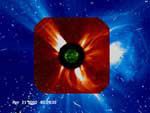 In
this new view, images from 7 instruments on 3 separate satellites are combined
in one frame. With so many coordinated spacecraft datasets and so many diverse
assignments, this visualization is striking in that it lines up the data to provide
a radical view of one solar event from sunspot to flare to the X-rays pinpointed
on that flare to the CME billowing out into space.
In
this new view, images from 7 instruments on 3 separate satellites are combined
in one frame. With so many coordinated spacecraft datasets and so many diverse
assignments, this visualization is striking in that it lines up the data to provide
a radical view of one solar event from sunspot to flare to the X-rays pinpointed
on that flare to the CME billowing out into space.
Credit: NASA / ESA / LMSAL
Full-disk
View
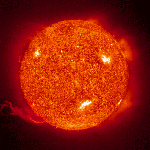 Millions
of miles away, CMEs from the Sun blast billions of tons of plasma into our magnetosphere
with the potential to disturb space systems, power grids and communications.
Millions
of miles away, CMEs from the Sun blast billions of tons of plasma into our magnetosphere
with the potential to disturb space systems, power grids and communications.
Credit: NASA / ESA
Amazing
Changing Sun
 Solar
maximum is the 2-3 year peak period (2000-2001 marked the peak of this cycle)
when activity is most complex and turbulent, and the space around Earth is most
disturbed.
Solar
maximum is the 2-3 year peak period (2000-2001 marked the peak of this cycle)
when activity is most complex and turbulent, and the space around Earth is most
disturbed.
Credit: NASA/ESA
Fountains
of Fire
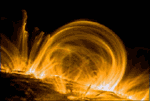 Close-up
images reveal an active surface with coronal loops emerging and disappearing all
over the Sun's surface and can span a length of about 250,000 miles, or about
30 times the diameter of Earth.
Close-up
images reveal an active surface with coronal loops emerging and disappearing all
over the Sun's surface and can span a length of about 250,000 miles, or about
30 times the diameter of Earth.
Credit: NASA / LMSAL
Sunspots
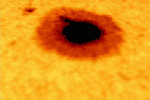 Sunspots
appear dark because they are cooler than the solar surface and can last for weeks
and can be as large as 80,000 km (over 6 planet Earths). Click here for the animated movie.
Sunspots
appear dark because they are cooler than the solar surface and can last for weeks
and can be as large as 80,000 km (over 6 planet Earths). Click here for the animated movie.
Credit: NASA / ESA
How
Do Active Regions Form?
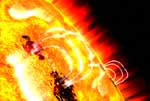 Peering
beneath the surface of AR 9393 revealed regions comprised of many small magnetic
structures that rise quickly from deep within the Sun. Click here for the animated movie.
Peering
beneath the surface of AR 9393 revealed regions comprised of many small magnetic
structures that rise quickly from deep within the Sun. Click here for the animated movie.
Credit: NASA
What
is the Aurora?
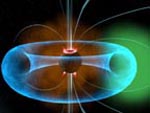 Plasma
from solar storms hit the Earth’s magnetic field, ejecting oxygen ions from
upper atmosphere. The ions flow along Earth's field lines until pressure from
solar wind stretches the field toard the night-side of the Earth like a rubber
band and snaps back.
Plasma
from solar storms hit the Earth’s magnetic field, ejecting oxygen ions from
upper atmosphere. The ions flow along Earth's field lines until pressure from
solar wind stretches the field toard the night-side of the Earth like a rubber
band and snaps back.
Credit: NASA
Why
Do we See Red in the Sky?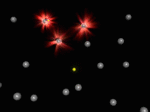 Collisions
between fast-moving electrons and the oxygen and nitrogen in Earth’s upper
atmosphere create aurora. The electrons from the magnetosphere transfer energy
to the gases, making them “excited.” As they “calm down” and
return to their normal state, they emit small bursts of energy in the form of
light. Oxygen produces a greenish-yellow or red light; nitrogen generally gives
off a blue light. Click here for the animated movie.
Collisions
between fast-moving electrons and the oxygen and nitrogen in Earth’s upper
atmosphere create aurora. The electrons from the magnetosphere transfer energy
to the gases, making them “excited.” As they “calm down” and
return to their normal state, they emit small bursts of energy in the form of
light. Oxygen produces a greenish-yellow or red light; nitrogen generally gives
off a blue light. Click here for the animated movie.
Credit: NASA
What Shields
The Earth?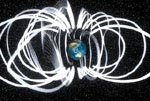 Solar
wind shapes and impacts Earth’s magnetic field. The magnetosphere extends
out about 65,000 km (40,000 miles) on the Sun side, and more than ten times that
distance on the opposite side, well beyond the Moon’s orbit.
Solar
wind shapes and impacts Earth’s magnetic field. The magnetosphere extends
out about 65,000 km (40,000 miles) on the Sun side, and more than ten times that
distance on the opposite side, well beyond the Moon’s orbit.
Credit: NASA
Storm of the Solar Cycle & Breaking News
Multi-Mission Solar View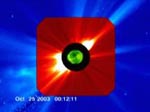 This view captures the October/November events using five instruments on three separate satellites. Click here for the animated video.
This view captures the October/November events using five instruments on three separate satellites. Click here for the animated video.
Credit: NASA / ESA / LMSAL
Comet makes Appearance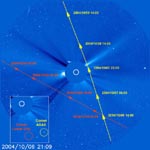 Comet ASAS (C/2004 R2) ranks among the brightest in recent times and passed about 10 million miles from the Sun, making SOHO the only witness to its journey.Click here for the animated video.
Comet ASAS (C/2004 R2) ranks among the brightest in recent times and passed about 10 million miles from the Sun, making SOHO the only witness to its journey.Click here for the animated video.
Credit: NASA / ESA
Unusual November Light Show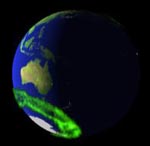 Both the IMAGE and Polar spacecraft were flying over the south pole and captured the aurora australis (southern lights) expanding and brightening on November 8. Click here for the animated video.
Both the IMAGE and Polar spacecraft were flying over the south pole and captured the aurora australis (southern lights) expanding and brightening on November 8. Click here for the animated video.
Credit: NASA
Sunspot Size of 20 Earths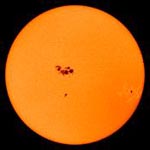 At 20 times the size of Earth, the largest sunspot observed since the fall 2003 appeared on July 23 and generated several medium-sized flares and CMEs over three and a half days. Click here for the animated video.
At 20 times the size of Earth, the largest sunspot observed since the fall 2003 appeared on July 23 and generated several medium-sized flares and CMEs over three and a half days. Click here for the animated video.
Credit: NASA / ESA
New Views From Trace
1. Nov 4, 2003 X-28 flare / Active Region 10486
2. Oct 28, 2003 X -17 flare / Active Region 10486
3. Aug 28, 2003 Active Region 10442
4. Aug 25, 2001 Active Region 9591
Credit: NASA / LMSAL
The Latest Observations
Genesis Comes Back Home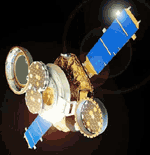 Genesis captured solar wind particles between Dec 5, 2001 and April 1, 2004. Researchers started sending out scientific samples to universities and other centers in January 2005.
Genesis captured solar wind particles between Dec 5, 2001 and April 1, 2004. Researchers started sending out scientific samples to universities and other centers in January 2005.
Credit: NASA
Solar Tsunamis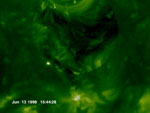
A view of a "Solar Tsunami," or "EIT Wave," observed on June 13, 1998. These tsunamis can travel the entire diameter of the Sun, lasting 10 to 60 minutes and travel about 300 km/second (186 miles/second). Click here for the animated video.
Credit: NASA / LMSAL
The Tsunami Trigger
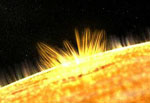 When the tsunami waves travel through the corona, they act like sonar pulses. Magnetic fields, densities, and temperature fluctuations cause the waves to slow down, speed up, or move in different directions. Click here for the animated video.
When the tsunami waves travel through the corona, they act like sonar pulses. Magnetic fields, densities, and temperature fluctuations cause the waves to slow down, speed up, or move in different directions. Click here for the animated video.
Credit: NASA
Seeing Through the Sun
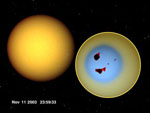 The Sun rotates roughly once every 27 days and knowing what’s rotating around to meet us is crucial. This visualization uses data to "see through" the Sun to the far side. Click here for the animated video.
The Sun rotates roughly once every 27 days and knowing what’s rotating around to meet us is crucial. This visualization uses data to "see through" the Sun to the far side. Click here for the animated video.
Credit: NASA / ESA
First 3-D View of Solar Eruptions
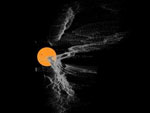 Seeing CMEs in 3D helps scientists understand the origin and processes that launch explosions of plasma. Because the CME gas is electrified, it spirals around the field, tracing out its shape.Click here for the animated video.
Seeing CMEs in 3D helps scientists understand the origin and processes that launch explosions of plasma. Because the CME gas is electrified, it spirals around the field, tracing out its shape.Click here for the animated video.
Credit: NASA / ESA
LASCO Perspective
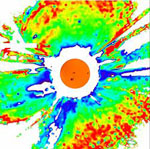 Modeling based on LASCO data. One imager extends up to 8.4 million km (5 million miles) from the Sun and the other 45 million km (30 million miles), almost the distance between Mercury and the Sun. Click here for the animated video.
Modeling based on LASCO data. One imager extends up to 8.4 million km (5 million miles) from the Sun and the other 45 million km (30 million miles), almost the distance between Mercury and the Sun. Click here for the animated video.
Credit: NASA / ESA
In Time for Olympic Flame, Sun Lights Up the Skies
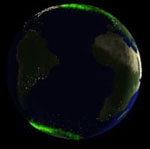 The Olympic flame in Athens was lit after traveling about 48,000 miles. Particles from the Sun traveled 93 million miles to light up skies in Iowa, Michigan, California, and New York. Click here for the animated video.
The Olympic flame in Athens was lit after traveling about 48,000 miles. Particles from the Sun traveled 93 million miles to light up skies in Iowa, Michigan, California, and New York. Click here for the animated video.
Credit: NASA / University of Iowa
Close-up of Southern Aurora from Space
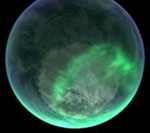 Flying over the South Pole, the IMAGE spacecraft these views around 7 pm ET on July 26. Ultraviolet light is invisible to the human eye, but can be detected by special instruments like those on IMAGE.
Click here for the animated video.
Flying over the South Pole, the IMAGE spacecraft these views around 7 pm ET on July 26. Ultraviolet light is invisible to the human eye, but can be detected by special instruments like those on IMAGE.
Click here for the animated video.
Credit: NASA / UC Berkeley
Scientists Look at Moon to Shed Light on Earth’s Climate
 Observations of the dark side of the Moon and satellite cloud data suggested Earth bounced less sunlight into space in the 1980s and 1990s. Studying these changes offers clues to changing climate.
Observations of the dark side of the Moon and satellite cloud data suggested Earth bounced less sunlight into space in the 1980s and 1990s. Studying these changes offers clues to changing climate.
Credit: NASA
Earthshine Highlights the Dark Side of the Moon
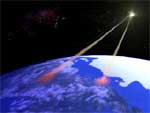 Only about two-thirds of the sunlight that reaches Earth actually makes it to our planet’s surface. The rest bounces off reflective surfaces into space.Click here for the animated video.
Only about two-thirds of the sunlight that reaches Earth actually makes it to our planet’s surface. The rest bounces off reflective surfaces into space.Click here for the animated video.
Credit: NASA
Venus Transits the Sun
 June 8 marked a rare twice-in-a-century event as Venus crosses the face of the Sun; the last two were in 1874 and 1882. It won't happen again until 2012and 2117.Click here for the animated video.
June 8 marked a rare twice-in-a-century event as Venus crosses the face of the Sun; the last two were in 1874 and 1882. It won't happen again until 2012and 2117.Click here for the animated video.
Credit: NASA
Satellite Observations
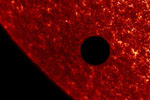 About 75 percent of the Earth’s population witnessed Venus crossing paths with the Sun on June 8. At about 1/30 the size of the solar disk, it was just barely visible with the naked eye.Click here to view the animated video.
About 75 percent of the Earth’s population witnessed Venus crossing paths with the Sun on June 8. At about 1/30 the size of the solar disk, it was just barely visible with the naked eye.Click here to view the animated video.
Credit: NASA / LMSAL
1882 Transit Observations
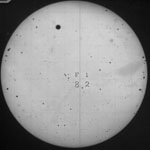 Expeditions were sent worldwide to observe the 1874 and 1882 transits and determine the size of the solar system. This is one of 11 plates from the 1882 American expedition.
Expeditions were sent worldwide to observe the 1874 and 1882 transits and determine the size of the solar system. This is one of 11 plates from the 1882 American expedition.
Credit: U.S. Naval Observatory
Other ‘SORCEs’ of Sun-Block are Observed
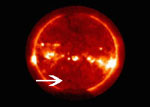 The slightest change in the Sun’s output is crucial to our climate system; both the Venus Transit and the 2003 solar flares decreased total solar brightness by three-tenths of one percent for one week. Click here for the animated video.
The slightest change in the Sun’s output is crucial to our climate system; both the Venus Transit and the 2003 solar flares decreased total solar brightness by three-tenths of one percent for one week. Click here for the animated video.
Credit: NASA / NOAA
SORCE's Anniversary and Once-in-a-Lifetime Observations
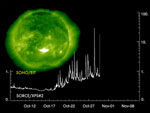 To put the three-tenths of one percent into perspective, the last time Earth experienced that sort of decrease (but over 50 years), Earth experienced the “Little Ice Age.
Click here for the animated video.
To put the three-tenths of one percent into perspective, the last time Earth experienced that sort of decrease (but over 50 years), Earth experienced the “Little Ice Age.
Click here for the animated video.
Credit: NASA / LASP
Tracking the Solar Spectrum
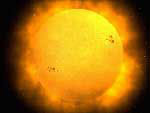 Radiation from the Sun consists of electromagnetic waves with a wide range of wavelengths reaching different levels of Earth's atmosphere, land, and oceans.
Click here for the animated video.
Radiation from the Sun consists of electromagnetic waves with a wide range of wavelengths reaching different levels of Earth's atmosphere, land, and oceans.
Click here for the animated video.
Credit: NASA
2004 Press Conferences
Safe Zone becomes the Hot Zone
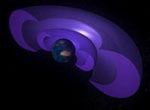 A gap in the Van Allen radiation belts about 7,000 km (4,350 miles) to 13,000 km (8,110 miles) above Earth's surface was long considered a "safe zone" from the harmful radiation that damages satellites.
Click here for the animated video.
A gap in the Van Allen radiation belts about 7,000 km (4,350 miles) to 13,000 km (8,110 miles) above Earth's surface was long considered a "safe zone" from the harmful radiation that damages satellites.
Click here for the animated video.
Credit: NASA
Signs of a Hot Zone
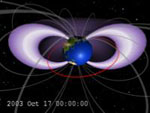 In October 2003, CMEs pushed Earth’s outer atmosphere into interplanetary space, filling the safe zone's gap and creating a new radiation belt. The red ring represents the potential orbit of a satellite.
Click here for the animated video.
In October 2003, CMEs pushed Earth’s outer atmosphere into interplanetary space, filling the safe zone's gap and creating a new radiation belt. The red ring represents the potential orbit of a satellite.
Click here for the animated video.
Credit: NASA
Signs of a Hot Zone
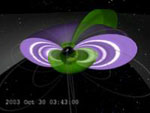 The plasmasphere (green) is blown out to the magnetopause (gray barrier), the main point of contact between the solar wind and Earth’s protective magnetic field lines.
Click here for the animated video.
The plasmasphere (green) is blown out to the magnetopause (gray barrier), the main point of contact between the solar wind and Earth’s protective magnetic field lines.
Click here for the animated video.
Credit: NASA
Blast Wave Blows through the Solar System
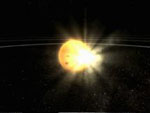 This tour of a Fall 2003 CME comes courtesy of solar sentinel SOHO, IMAGE and Polar at Earth, Mars Odyssey, Ulysses near Jupiter, Cassini at Saturn, and Voyager 1 and 2 at the edge of the solar system. Click here for the animated movie.
This tour of a Fall 2003 CME comes courtesy of solar sentinel SOHO, IMAGE and Polar at Earth, Mars Odyssey, Ulysses near Jupiter, Cassini at Saturn, and Voyager 1 and 2 at the edge of the solar system. Click here for the animated movie.
Credit: NASA
CME Reaches Mars
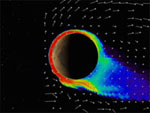 While none of NASA's satellites near Earth were damaged, an instrument on the Mars Odyssey spacecraft was disabled by radiation in Mars' orbit. Click here for the animated movie.
While none of NASA's satellites near Earth were damaged, an instrument on the Mars Odyssey spacecraft was disabled by radiation in Mars' orbit. Click here for the animated movie.
Credit: NASA / Nagoya University
Jupiter and Saturn
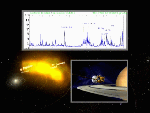 Ulysses registered the solar particles around Nov. 7 near Jupiter, while the Cassini-Huygens mission detected solar radio bursts from particularly intense flares on Oct. 28 and Nov. 4.
Click here for the animated movie.
Ulysses registered the solar particles around Nov. 7 near Jupiter, while the Cassini-Huygens mission detected solar radio bursts from particularly intense flares on Oct. 28 and Nov. 4.
Click here for the animated movie.
Credit: NASA / ESA / ASI / University of Iowa
Voyager at the Heliopause
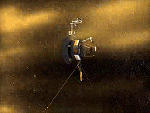
Voyager 2, located about 7 billion miles (11 billion km) from the Sun, experienced the blast around mid-May while its counterpart, Voyager 1, over 8 billion miles away, saw the blast in early July.
Click here for the animated movie.
Credit: NASA
Expansion of the Heliopause
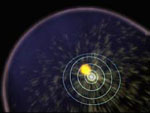
A sort of bubble envelops our solar system and a boundary called the heliopause separates our solar system from the vastness of interstellar space. This boundary is fluid and changes with solar cycles and activity.
Click here for the animated movie.
Credit: NASA
The Spacecraft
ACE Spacecraft
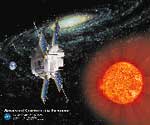
The Advanced Composition Explorer (ACE) spacecraft is designed to identify matter that comes near the Earth and to help scientists better understand the formation and evolution of the solar system. This matter can come from the Sun, the 'space' between planets, and the Milky Way galaxy. When reporting space weather, ACE can provide an advanced warning (about 1 hour) of geomagnetic storms that can affect Earth systems. It was launched on August 25, 1997.
Credit: NASA / ISAS
Cluster Spacecraft
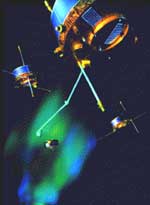
Four identical spacecraft carrying a complement of 11 identical instruments each, were launched in July and August 2000. The four fly in a close pyramid formation, giving scientists three-dimensional views of near-Earth space. Specifically they investigate the solar wind as it crashes into our planet's magnetosphere.
Credit: NASA / ESA
GeoTail Spacecraft

A joint US/Japanese project, 'Geotail' was the first in a series of five satellites to better understand the interaction of the Sun, the Earth's magnetic field and the Van Allen radiation belts. Located in the magnetic tail of the magnetosphere on the night side of the Earth, an area critical to understanding the interaction of the Sun and Earth, its primary objective is to study dynamics of the Earth's magnetotail. The spacecraft was launched on July 24, 1992
Credit: NASA / ISAS
Image Spacecraft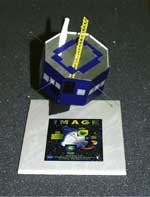
Launched on March 25, 2000, the Imager for Magnetopause-to-Aurora Global Exploration (IMAGE) spacecraft obtains continuous global images of charged particles in the Earth's magnetosphere and tracks these solar storms. One such storm can launch huge amounts of plasma from the Sun at more than 1 million mph and affect Earth systems.
Credit: NASA
Polar Spacecraft
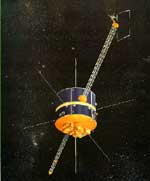
'Polar' was launched on February 24, 1996 to study the geospace, or Earth's space environment. It performs simultaneous, coordinated measurements of key regions including observations of the entry and transport of solar plasma over Earth's magnetic poles, imaging of the northern aurora (Northern Lights), and investigations of solar wind properties.
Credit: NASA
RHESSI Spacecraft
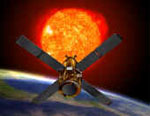
The Ramaty High-Energy Solar Spectroscopic Imager (RHESSI) spacecraft watches the Sun in X-rays and gamma rays. RHESSI is the first spacecraft to make high-resolution movies of flares using their high-energy radiation. Launched on Feb. 5, 2002, its primary objective is to study the secrets of how solar flares are produced in the Sun's atmosphere. RHESSI orbits Earth about 15 times a day and spins on its axis every 4 seconds.
Credit: NASA
SDO Spacecraft
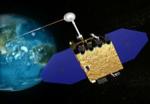
The Solar Dynamics Observatory (SDO) is slated to launch in 2008. It will study the solar variations that influence life on Earth and humanity’s technological systems.
Credit: NASA
SOHO Spacecraft
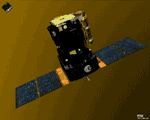
Advance warning of potential bad weather in space is now possible thanks to the Solar and Heliospheric Observatory (SOHO) spacecraft launched in 1995. SOHO operates at a vantagepoint of about 1 million miles out in space between the Sun and Earth. It carries 12 instruments and is a joint project with the European Space Agency.
Instruments include the Michelson Doppler Imager (MDI) that allows scientists to use a sort of ultrasound capability to see the far side of the Sun and inside it. The Large Angle Spectrometric Coronograph (LASCO) mimics an eclipse in order to study the Sun's corona, or outer atmosphere. The Extreme ultraviolet Imaging Telescope (EIT) allows for a full-disk view of the Sun.
Credit: NASA / ESA
SORCE Spacecraft
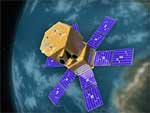 The SOlar Radiation and Climate Experiment (SORCE) maintains a 24-year legacy of solar output monitoring that should help explain and predict the effect of the Sun on the Earth's atmosphere and climate. With four instruments, it orbits Earth 15 times a day and analyzes the Sun's energy in visible, ultraviolet and infrared wavelengths that can be used to determine solar heating of Earth's oceans, ice, land and absorbing layers of the atmosphere. SORCE launched in January 2003.
The SOlar Radiation and Climate Experiment (SORCE) maintains a 24-year legacy of solar output monitoring that should help explain and predict the effect of the Sun on the Earth's atmosphere and climate. With four instruments, it orbits Earth 15 times a day and analyzes the Sun's energy in visible, ultraviolet and infrared wavelengths that can be used to determine solar heating of Earth's oceans, ice, land and absorbing layers of the atmosphere. SORCE launched in January 2003.
Credit: NASA / LASP
STEREO Spacecraft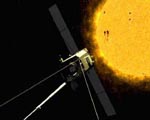 The Solar TErrestrial RElations Observatory (STEREO) is scheduled to launch in February 2006 and includes two nearly identical spacecraft that will image the Sun in 3-D for the first time ever.
The Solar TErrestrial RElations Observatory (STEREO) is scheduled to launch in February 2006 and includes two nearly identical spacecraft that will image the Sun in 3-D for the first time ever.
Credit: NASA
TIMED Spacecraft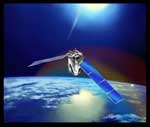 Launched in Dec. 2001, the Thermosphere-Ionosphere-Mesosphere-Energetics and Dynamics (TIMED) spacecraft is the first to study the region of our atmosphere that acts as a gateway between Earth's environment and space, called the Mesosphere and Lower Thermosphere/ Ionosphere (MLTI). Scientists hope to get a better understand of how Earth's environment and surroundings are impacted by solar energy.
Launched in Dec. 2001, the Thermosphere-Ionosphere-Mesosphere-Energetics and Dynamics (TIMED) spacecraft is the first to study the region of our atmosphere that acts as a gateway between Earth's environment and space, called the Mesosphere and Lower Thermosphere/ Ionosphere (MLTI). Scientists hope to get a better understand of how Earth's environment and surroundings are impacted by solar energy.
Credit: NASA / APL
TRACE Spacecraft
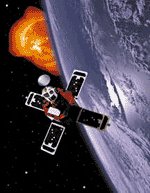 NASA's Transition Region and Coronal Explorer (TRACE) points its powerful telescope at the "transition region" of the Sun's atmosphere, a highly volatile and dynamic region. Sensitive to ultraviolet and extreme-ultraviolet wavelengths of light, which are invisible to the human eye, scientists are given dynamic views of solar explosions and coronal mass ejections (CMEs). TRACE was launched on April 1, 1998.
NASA's Transition Region and Coronal Explorer (TRACE) points its powerful telescope at the "transition region" of the Sun's atmosphere, a highly volatile and dynamic region. Sensitive to ultraviolet and extreme-ultraviolet wavelengths of light, which are invisible to the human eye, scientists are given dynamic views of solar explosions and coronal mass ejections (CMEs). TRACE was launched on April 1, 1998.
Credit: NASA / LMSAL
Voyager Spacecraft
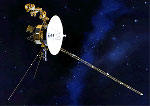 The two Voyager spacecraft send back about 12 hours' worth of data per day at about the speed of a slow modem and with the power of a 28-watt nightlight. They are approaching the edges of our solar system.
The two Voyager spacecraft send back about 12 hours' worth of data per day at about the speed of a slow modem and with the power of a 28-watt nightlight. They are approaching the edges of our solar system.
Credit: NASA / LMSAL
Wind Spacecraft
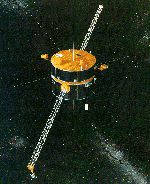 The 'Wind' spacecraft provides complete plasma, energetic particle, and magnetic field input for magnetospheric and ionospheric studies. It detects the magnetic field carried by coronal mass ejection clouds, but its location only allows scientists about an hour's notice. It can estimate how severe the space storm will be by measuring the direction of the magnetic field, though. It was launched on November 1, 1994.
The 'Wind' spacecraft provides complete plasma, energetic particle, and magnetic field input for magnetospheric and ionospheric studies. It detects the magnetic field carried by coronal mass ejection clouds, but its location only allows scientists about an hour's notice. It can estimate how severe the space storm will be by measuring the direction of the magnetic field, though. It was launched on November 1, 1994.
Credit: NASA